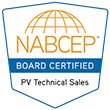 Although the sun powers solar panels all year, there are a few reasons why spring is a good time to consider making the switch.
Although the sun powers solar panels all year, there are a few reasons why spring is a good time to consider making the switch.
Why Install Solar in Spring?
- Summer months generate the highest production due to longer days and warmer temps, allowing you to store excess power for future use or sell it back to the grid
- Households can avoid increased energy costs from A/C use
- Spring tax refunds can generate additional savings in 2025 with the Federal Solar Tax Credit
In Ohio, it can be easy to forget about the sun in the winter – but spring will be here before we know it!
Contrary to popular belief, solar does work in Ohio year-round, as long as the sun is shining. This means that PV systems will produce power during the winter months – but shorter days and more clouds will result in less power than you’ll get from long summer days. In order to maximize your initial investment, we recommend beginning the installation process during the winter and spring months.
A typical high-quality residential solar installation can take several weeks to months from the date you sign a contract to the date you can flip the switch to turn it on. This is because there are several important factors and steps that need to occur prior to installation to guarantee a quality system:
1. System Design: We design PV systems to fit your needs. We’ll review your utility bill, historical usage, future plans, budget, and physical location to determine the most efficient and cost-effective system.
2. Technical Site Visit: We schedule a time to send somebody out to double-check the installation location. We’ll take measurements, check out the wiring in your house, and make sure the designed system will work for you.
3. Engineering: We’ll get your design drafted and obtain the necessary engineering documents to submit to your jurisdiction and utility.
4. Permitting and Interconnection: Ecohouse plays by the rules! We take care of your permitting and interconnection needs. This includes support for getting HOA approval, zoning, building and electrical permits, and utility interconnection. This process can take several weeks, depending on the number of permits and rules in your jurisdiction, their processing time, and the speed at which your utility processes interconnection applications.
5. Materials Check: If we don’t have the equipment we need on hand, we’ll have to order them. Supply chain constraints have eased over the past couple of years, which means delays are far less likely – but not impossible.
6. Installation: A typical installation takes just a couple of business days, but complicated or larger systems may take longer. This is our favorite step… but it’s not the last!
7. Review: We’ll test your system, then our team will review all the pieces to make sure it’s built to our standards.
8. Inspection: Many jurisdictions perform their own inspections, so we need to coordinate between your availability and their schedule to get the required inspections. In some cases, we use third-party inspectors.
9. Permission to Operate: After your system is inspected, we’ll submit inspection documents to your utility. They will review your installation and notify you when you have permission to operate your PV system. AEP customers typically receive this within two weeks of their inspections.
10. Other factors:
-
- Revisions: It’s important to get your system designed to meet your needs prior to building, so we are happy to make changes throughout the process at your request, or due to unforeseen circumstances that require us to move things around once we start building. However, revisions must go back through engineering and permitting/interconnection prior to installing.
- Scheduling constraints: It can be more difficult to predict an installation schedule during the summer months. That is our busy season – which means it is also the busy season for municipal building departments and utilities. Scheduling site visits, installations, and inspections around vacations and the back-to-school rush can also cause delays.
- Weather: For the safety of our crew, we will reschedule installations if weather conditions are dangerous for roof work. This includes high winds, thunderstorms, icy conditions, hail, and extreme temperatures.





 Project Calculator
Project Calculator